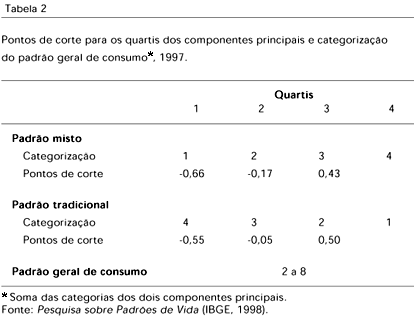This study evaluated factors associated with dietary patterns in the Brazilian population based on the Living Standards Survey conducted in the Northeast and Southeast regions of the country. Multi-stage probability sampling was employed to select the households, and for the present analysis 5,121 adults aged 20 to 50 years were included. Pregnant women and individuals reporting chronic health conditions were excluded. Through principal component analysis, two major family dietary patterns were identified: a mixed pattern, in which all groups and foods have approximately the same factor loading, and a second pattern based main1y on rice and beans, which was called a traditional diet. Weight and height were measured in the households, and food intake was based on a 21-item semi-quantitative family questionnaire. The Northeast (as compared to the Southeast) was negatively associated with the mixed pattern. Body mass index was positively associated with the mixed pattern, whereas leisure physical activity and Black skin color were negatively associated with the mixed pattern. Schooling and income levels explained most of the dietary variance, but after adjusting for education and income, region of residence remained significantly associated and was the third most important explanatory variable.
Nutrition Surveys; Body Mass Index; Feeding Patterns

 Factors associated with dietary patterns in the urban Brazilian population
Factors associated with dietary patterns in the urban Brazilian population


